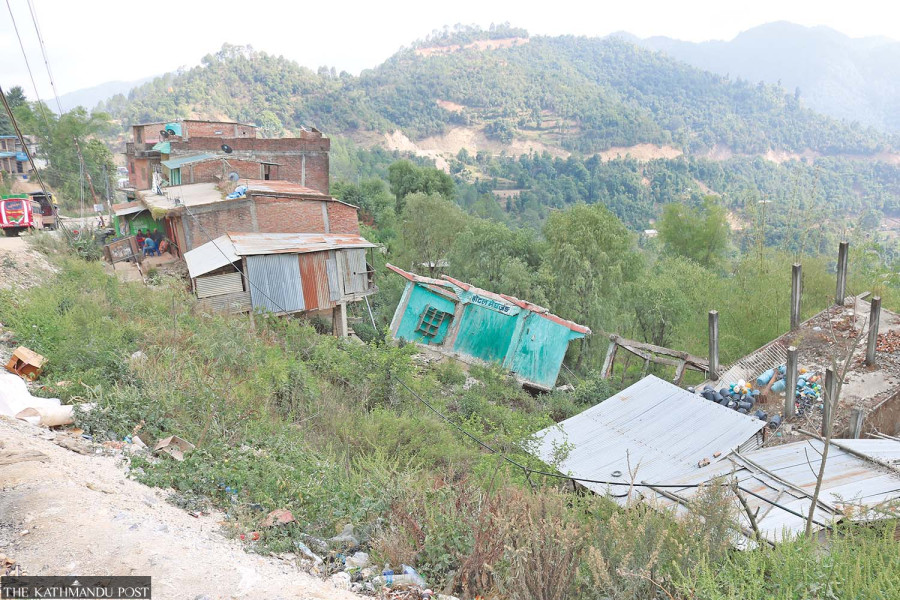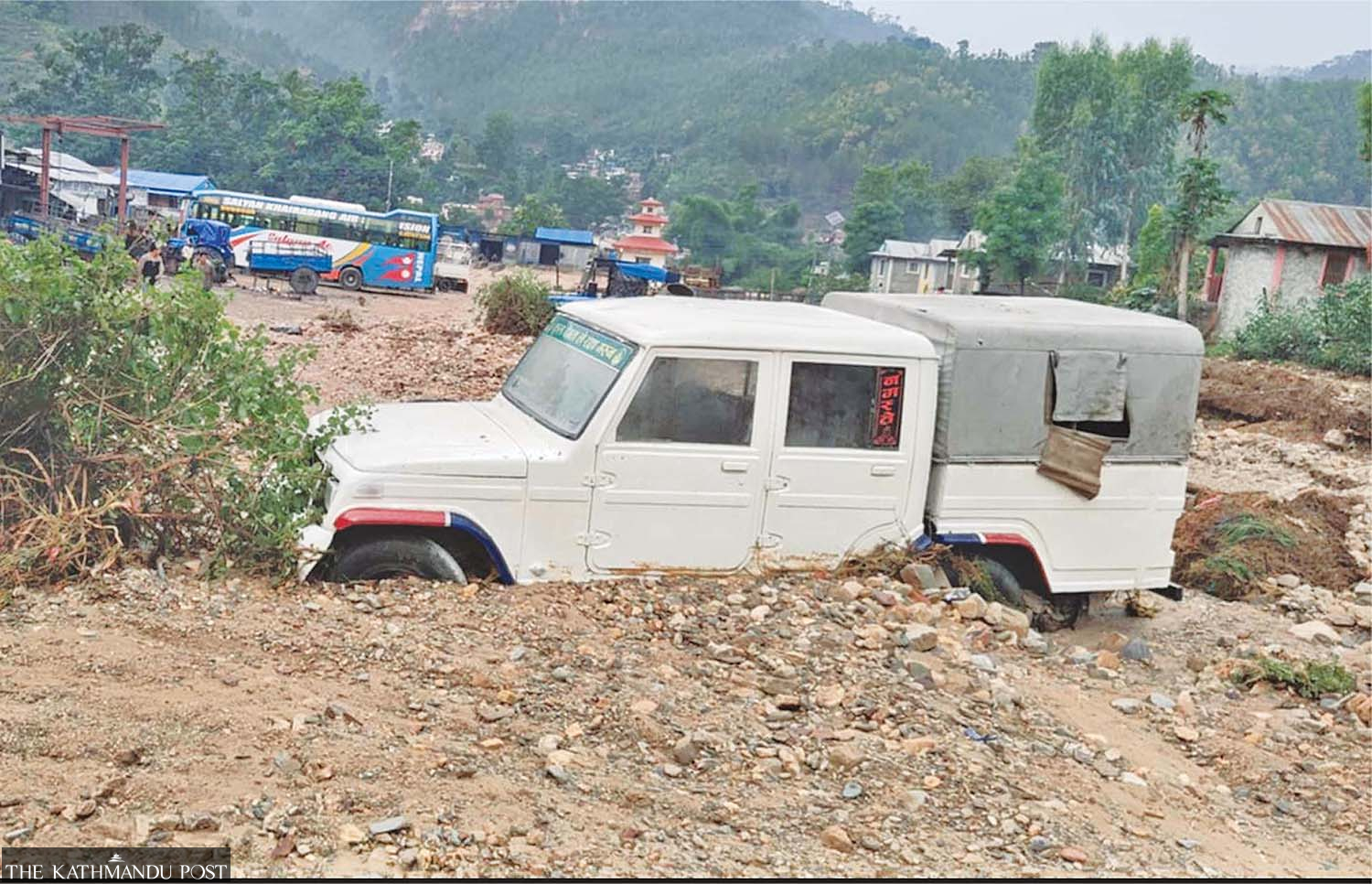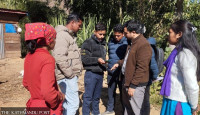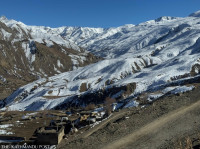Karnali Province
100 settlements in Salyan at risk of monsoon disasters
19 settlements are at risk from flooding, 73 from landslides, and 11 from inundation, data compiled by local authorities show.
Biplab Maharjan
Recent monsoon rains have put over 100 settlements across Salyan district at risk of floods, landslides and inundation that may displace hundreds of families and damage infrastructure.
According to district authorities, the monsoon-induced disasters destroyed six houses, around a dozen houses incurred partial damage while more than two dozen houses have been exposed to high risk of floods and landslides in the district as of now this year.
Last week, a flash flood in the Resamkhola stream in ward 12 of Sharada Municipality partially buried a Mahindra Bolero jeep parked for repair in the Resamjyula settlement and washed away several goods from a nearby workshop. In the same area, Shiva Secondary School building and some other houses in Muldanda were left vulnerable to future disasters.
Similarly, floodwaters from the Bhagwatikhola stream severely damaged four homes and a shop near Srinagar Bazar in ward 1 of Sharada Municipality. In Kapurkot Rural Municipality, the main market area has long been threatened by the nearby Khara landslide, which has already swept away more than half a dozen houses and rendered many others unsafe. Despite the dangers, families continue to reside in these cracked and unstable homes.
But these are just a few settlements among more than 100 settlements identified as vulnerable. Data compiled by local authorities show that 19 settlements are at risk from flooding, 73 from landslides and 11 from inundation in Salyan, a hill district of Karnali province. Of these, 35 settlements have been categorised as high-risk. Unfortunately, despite the clear and ongoing threats, these areas have yet to be relocated by authorities.
At-risk settlements are scattered across all 10 local units of the district. In Sharada Municipality, areas such as Srinagar Bazar, Shantinagar, Resamjyula, Ramekhola, and Khairabang have been marked as vulnerable. Likewise, in Bangad Kupinde Municipality, settlements including Gairibazar, Garche, and Kotbhir face similar threats. Bagchaur Municipality has high-risk areas like Dobhan Bazar, Simkholi and Baphukhola. Kapurkot Municipality is struggling with threats in places like Gairibang, Simalkuna, and Kapurkot Bazar, while Chhatreshwari, Kalimati, Kumakh, Siddhakumakh, and Darma rural municipalities all have multiple settlements that are at risk of floods and landslides.
To mitigate the threat, efforts have been made over the years to construct embankments, retaining walls, and conduct tree plantation campaigns in vulnerable areas. However, these measures have had limited success. Recurrent monsoon-triggered disasters continue to damage property and take lives. Experts point out that haphazard road construction by using bulldozers and excavators, along with rampant extraction of sand, gravel and stones have worsened the situation.
Netra Prasad Subedi, chief district officer and chairman of the District Disaster Management Committee, said that preparedness efforts are ongoing in coordination with all local units and the Red Cross. “We’ve been constructing gabion walls in vulnerable locations to reduce risks,” he said, adding that awareness campaigns are also being conducted to inform communities about disaster preparedness.
According to Shikhar Chapai, chief of the Soil and Watershed Management Office in Surkhet, landslides last year affected 126 hectares of land across 90 different locations in Salyan. He blames extensive deforestation and soil erosion due to careless road construction for exacerbating the landslide problem.
"Since the federal government moved soil conservation offices to provincial headquarters, we haven't been able to carry out adequate landslide control work at the district level,” said Chapai. However, two municipalities in Salyan have been selected for landslide control programmes in the upcoming fiscal year, he added.
The local units have been struggling to mitigate the monsoon-induced disasters and relocate the perilous settlement due to budget shortage.
Durga Bahadur Pun, chairman of Kapurkot Rural Municipality, said nearly a dozen settlements in his rural municipality face landslide threats, with Kapurkot Bazar and Sallam being the most vulnerable. “We’ve relocated a few families from Sallam, but we’ve not been able to shift residents of Kapurkot Bazar. We’ve built some embankments, planted trees and installed gabion walls using both local and federal funds, but every year the rain undoes our work,” said Pun.
In Kalimati Rural Municipality, chairman Dan Bahadur Khatri recalled a deadly landslide two decades ago in ward 6 that killed five members of a single family. While no such tragedy has occurred recently, he credits gabion walls and other small mitigation works for preventing further displacement.
Similarly in Bagchaur Municipality, wards 4, 9, and 12 are especially vulnerable, with Dobhan Bazar facing continuous erosion and flood risk. “We’ve built gabion walls along the Baphukhola [stream] to reduce damage, but we are limited in our capacity to undertake large-scale work due to budget crunch,” said Hari Bahadur Kathayat, acting chief administrative officer of Bagchaur. He, however, claimed that local authorities have prepared a disaster response plan for this year’s monsoon.





 20.12°C Kathmandu
20.12°C Kathmandu











